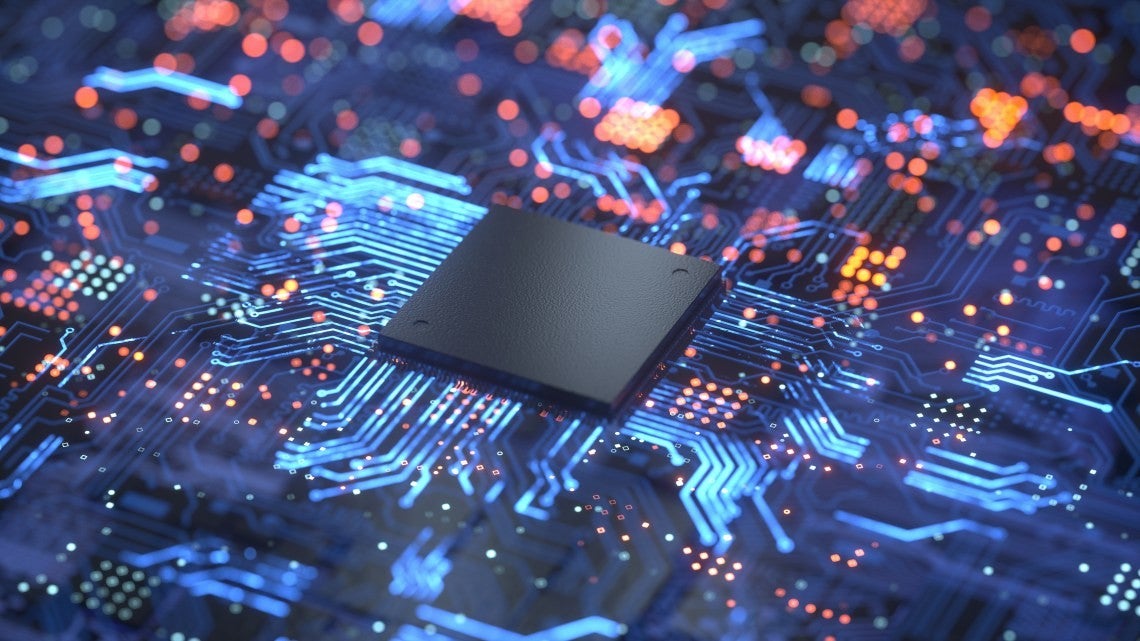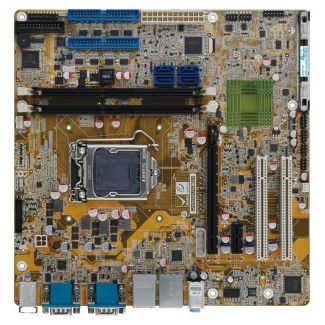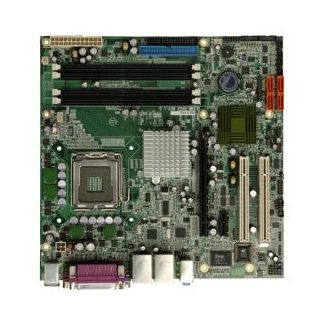Embedded Single Board Computers SBCs
Tekdis offers a wide selection of all form factors of embedded single board computers (SBCs) including CPU and IO options to suit various applications, ranging from the smallest PICO to ATX, built with IO connectors direct to the PCB. COM Express, SMARC and Q7 sized System on Modules (SOMs) are designed to plug into a carrier board via a high-density connector and the IO is then provided from the carrier board. PICMG are suitable for backplane-based designs in rack systems. We have the experience and know how to select the proper storage, and communication modules (LTE, WLAN) and can license/image with operating systems prior to shipping. Contact our team today to find out the best solution and pricing.

-
 IMB-H810-i2 micro-ATX Motherboard
IMB-H810-i2 micro-ATX MotherboardmicroATX motherboard supports 22nm LGA1150 Intel® Core™ i7/i5/i3, Pentium®, Celeron® CPU per Intel® H81
-
 IMB-9454G micro-ATX MotherboardEnd of Life
IMB-9454G micro-ATX MotherboardEnd of Lifemicro-ATX Motherboard with Intel Core 2 Duo, Pentium® 4/ Pentium® D/ Celeron® D FSB 533/800/1066MHz CPU, VGA, Dual PCIe GbE, SATA II, USB 2.0, 6 COM, & Audio
Single Board Computers
Single board computers - or SBCs for short - are compact computing devices that integrate all essential components onto a single circuit board, including CPU, RAM, storage, and I/O ports. They are widely used in embedded systems, education, prototyping, and IoT (Internet of Things) applications due to their cost-effectiveness, small size, and versatility. Single Board Computers are available in various form factors, with the half-size and full-size boards adhering to the PC/104 standard being the most prevalent. These boards also offer the capability of being stacked together, enabling the creation of a multi-board system, though like many of SBC features, this function is entirely optional.
Single board computers have become invaluable for tech enthusiasts, developers, and industries in need of compact computing solutions, as they offer a convenient platform for fast development, making them suitable for projects that require computing power without the complexity of traditional PCs.
Uses of Single Board Computers
Single board computers are commonly deployed in embedded applications where their hardware cannot be expanded, featuring only the necessary input and output capabilities for their designated tasks. They are frequently integrated into rack systems and other standardised frameworks, as they can ensure reliable and swift incorporation into larger systems.
Owing to their durability, straightforward designs, and easy replaceability, single board computers are also often used as basic controllers across various industries. They can serve as controllers for sizable industrial equipment, and the military sometimes used them within specialised tablet computers, drones, and surveillance system control units.
Thanks to their affordability, they are extensively used in classrooms and other forms of education, facilitating programming learning, robotics, and 3D printing.
The versatility of single board computers also makes them ideal for experimentation and innovation, and as such, they have become frequently embraced for home projects, home networking setups, and applications across the Internet of Things.
Features of Single Board Computers
Single Board Computers are useful for a vast range of purposes. Some SBC advantages include:
- SBCs are versatile, allowing use across a wide variety of applications.
- SBCs are affordable.
- They are easy to set up and easy to use, as all of their components are integrated into the board, allowing for a simplified setup and operation.
- SBCs offer powerful processing power.
- Despite this, they consume less energy, making them a cost-effective choice for the energy conscious.
- They come in a compact size, making them ideal for those on the go or looking to save space at home.
- SBCs generally offer greater sturdiness and resilience than most personal computers, making them the durable option.
Factors to Consider While Buying a Single Board Computer Online
- Your intended use: Arguably the most obvious (but nonetheless, most important) aspect you should consider before buying a single board computer is the ability to perform the specific tasks you need it to. This will clearly be a very individualised list of duties, so in order to make the smartest possible purchase, we recommend that you write an actual list of the specific tasks you need a single board computer for. This in turn will inform a list of all the functions that you will need in an SBC, which will help you pinpoint which make and model you need.
- Size & form factor: The size and physical configuration of your SBC should be crucial considerations. If you already have a pre-designed enclosure, it's vital to verify that the board aligns with the enclosure's size requirements, ideally without the need for subsequent modifications. While larger computer boards are generally more suitable for applications such as cyberdecks, NAS systems, and routers, smaller SBCs tend to be more advantageous for embedded projects like keyboards, mice, and handheld video games.
- Performance & memory: When assessing the performance of a single-board computer, don’t forget to consider the capabilities of the processor. Additionally, it's important to assess the available RAM in the SBC. Single-board computers usually provide a range of RAM options, from as little as 512MB to as much as 16GB. For basic productivity tasks, casual web browsing, and playing fewer demanding games, a minimum of 2GB should suffice. However, with 8GB of RAM, you can comfortably run Windows, enjoy seamless gaming experiences, multitask efficiently, and even execute machine learning models on your compact SBC.
Why choose Tekdis?
Tekdis is a leading-edge tech company that offers innovative computing tech and quality customer service. We specialise in industrial computing, display, medical, and RF solutions for system integrators and OEM manufacturers. At Tekdis, we take pride in understanding the requirements of each and every customer, and then providing them with the best possible solutions. We take satisfaction in offering our customers the highest quality of reliable distribution facilities, professional selling procedures, and technical support. We have warehouse facilities in Melbourne and offices in Sydney, as well as the UK, and the USA.
We are continually adding new products to our expanding product line based on emerging technologies and evolving market needs. You can check out our embedded single board computers here, or head over to the Tekdis website to browse our wide range of products. If you cannot find the particular product you’re looking for on our website, please don’t hesitate to let us know via the Tekdis Contact Us page, and one of our friendly staff will be able to help you directly.
Single Board Computers FAQs
What is a Single Board Computer (SBC)?
A Single Board Computer - which is often shortened to SBC - is a complete computer built on a single circuit board. They are often designed to be compact, and they typically contain all the essential components needed for a functional computer, including the storage, input/output ports, the processor (CPU), the memory (RAM), and sometimes additional components such as graphics processing units (GPUs) or wireless networking modules.
What is the difference between a single board computer and a motherboard?
A motherboard is a key component of a traditional desktop or tower computer. It is a large circuit board that provides the platform for connecting various hardware components, including the CPU, RAM, storage devices, graphics cards, and more. In contrast, an SBC is a self-contained computer on a single board, meaning it integrates most of these components directly onto a smaller circuit board.
What is installed inside a single board computer?
Inside a single board computer, you will typically find the CPU (Central Processing Unit) that execute the instructions, a RAM Random Access Memory (RAM) that is used for temporary data storage while the computer is running, built-in storage (sometimes in the form of microSD card slots or eMMC), audio/video outputs, and sometimes some optional components like Wi-Fi/Bluetooth modules, GPUs or additional expansion headers. But it’s important to keep in mind that different brands and models of single board computers are all built differently.
What is the most popular single board computer?
Like anything else when it comes to technology, the answer to this is as subjective as it is divisive. Some of our bestselling single board computers include the NANO-ULT3 EPIC SBC 6th Gen (from IEI Integration Corp) and the SCM187-4R8EI-184EVK SMARC v2.1 Mini Quad (from Axiomtek). But there’s no universal answer as to what the best single board computer is, because what’s best for someone else may not be what’s best for. If you want to find out what the best SBC for you is, get in touch with one of one of our knowledgeable staff members so you can tell them what your specific requirements are, and they can tell you which SBC can best remedy your particular needs.
Is a single board computer the same as a system on chip?
While both SBCs and SoCs are related to embedded computing, they are not the same.
An SBC is a complete computer on a single board, which may use a System on Chip (SoC) as its main processor. The SoC typically integrates the CPU, GPU, memory controller, and other components into a single chip.
A System on Chip (SoC) refers to the integration of multiple components and functions into a single chip. It can be used in various devices, including SBCs, smartphones, and IoT devices. SoCs are not limited to SBCs; they can be found in a wide range of electronics.


